Statistical Analysis Report: Evaluating Literacy Module Effectiveness
VerifiedAdded on 2023/01/19
|10
|1968
|24
Report
AI Summary
This report presents a statistical analysis of the effectiveness of supplemental literacy instructional modules compared to a standard literacy curriculum (control group). The analysis involved three investigations. Investigation 1 utilized two independent t-tests to compare the impact of Module A and Module B against the control group on reading comprehension scores, finding no significant differences. Investigation 2 employed a one-way ANOVA to assess the differences in comprehension scores across the control group and Modules A and B, again finding no significant differences. Investigation 3 used a multiple regression model to estimate the impact of self-esteem and WISCR IQ scores on changes in reading comprehension, revealing no statistically significant linear relationships. The report includes detailed statistical results, including means, standard deviations, t-test results, ANOVA tables, and regression coefficients, along with an assessment of assumptions and limitations of the analysis.
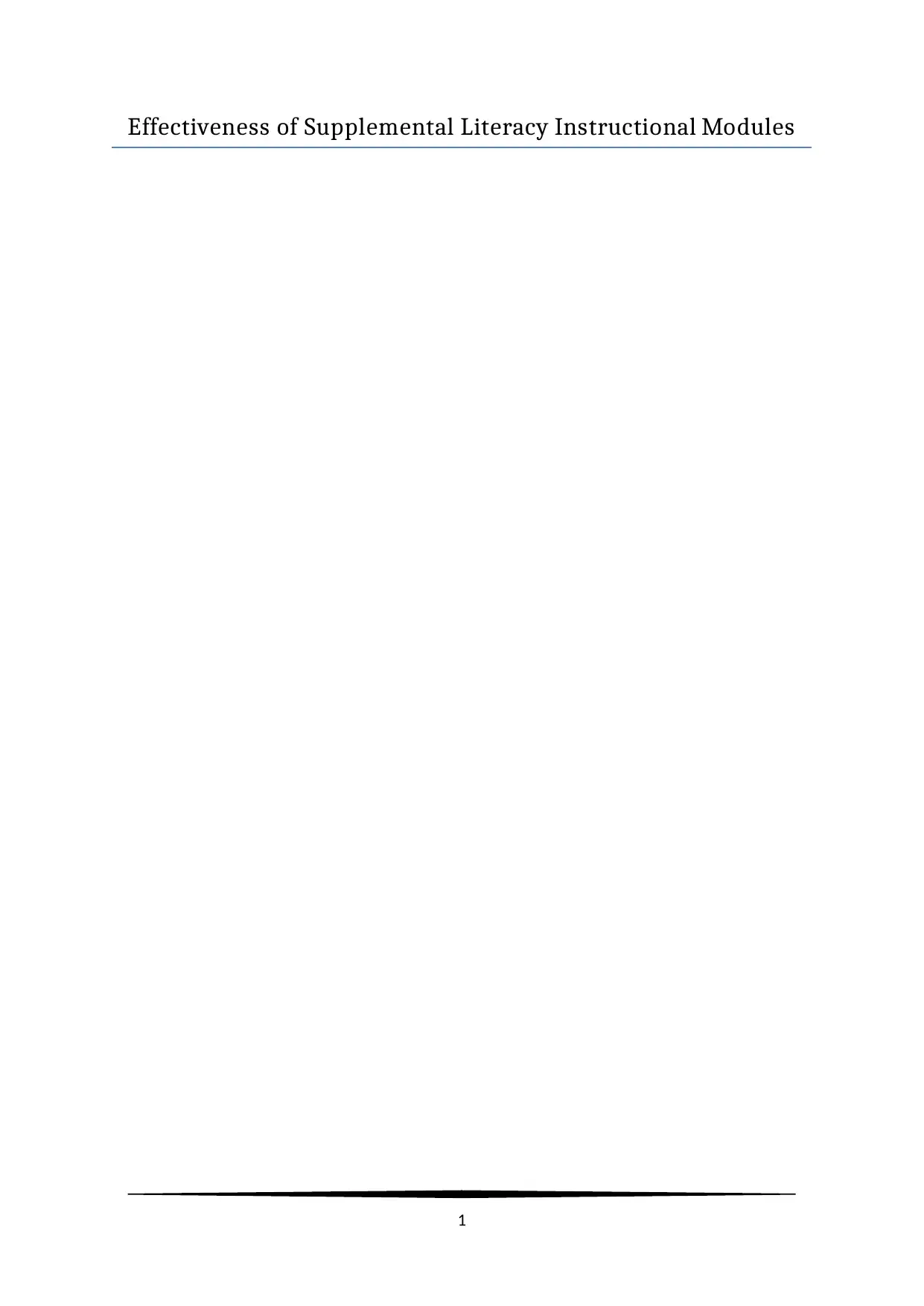
Effectiveness of Supplemental Literacy Instructional Modules
1
1
Paraphrase This Document
Need a fresh take? Get an instant paraphrase of this document with our AI Paraphraser
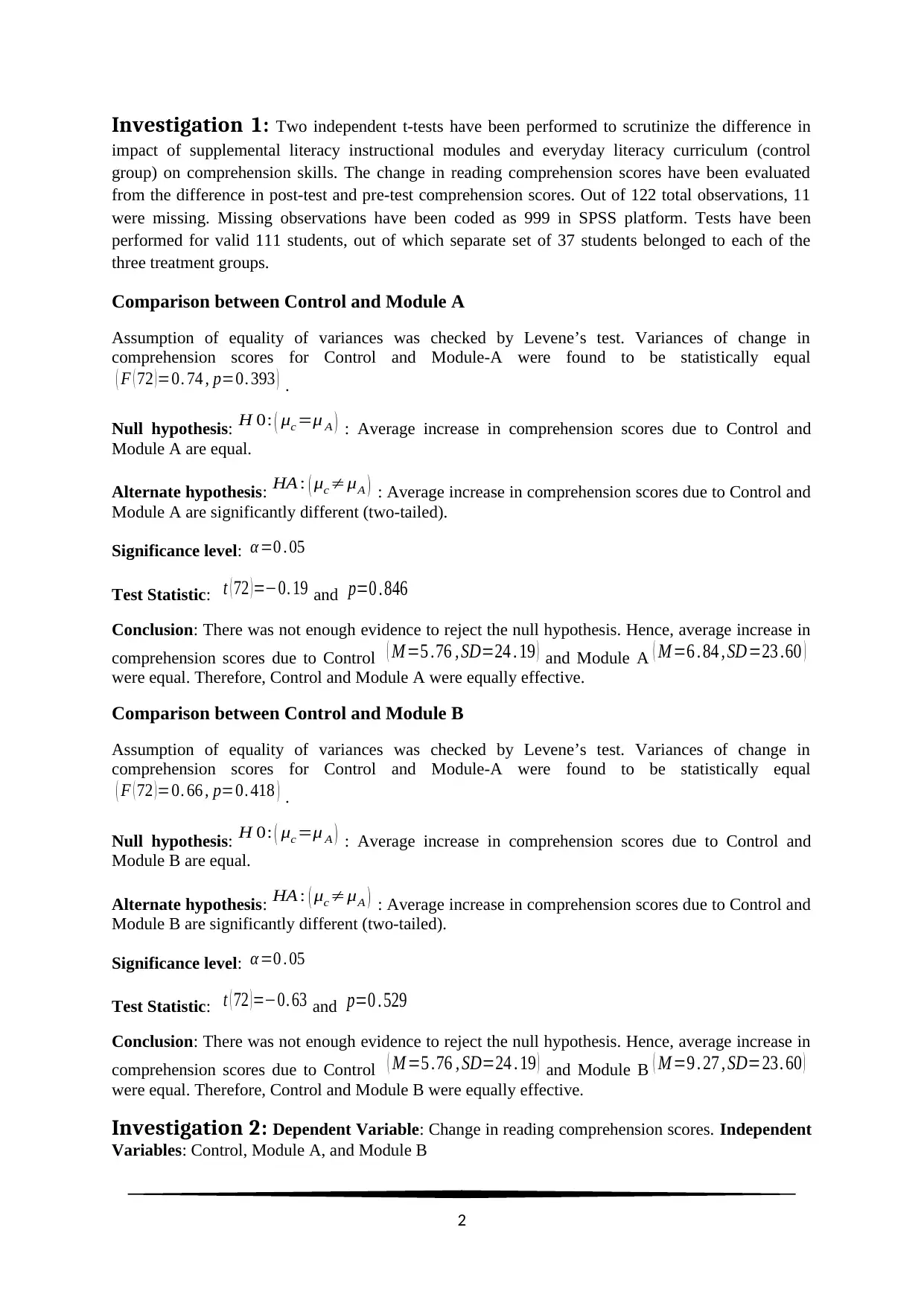
Investigation 1: Two independent t-tests have been performed to scrutinize the difference in
impact of supplemental literacy instructional modules and everyday literacy curriculum (control
group) on comprehension skills. The change in reading comprehension scores have been evaluated
from the difference in post-test and pre-test comprehension scores. Out of 122 total observations, 11
were missing. Missing observations have been coded as 999 in SPSS platform. Tests have been
performed for valid 111 students, out of which separate set of 37 students belonged to each of the
three treatment groups.
Comparison between Control and Module A
Assumption of equality of variances was checked by Levene’s test. Variances of change in
comprehension scores for Control and Module-A were found to be statistically equal
( F ( 72 ) =0. 74 , p=0. 393 ) .
Null hypothesis: H 0: ( μc =μ A ) : Average increase in comprehension scores due to Control and
Module A are equal.
Alternate hypothesis: HA : ( μc ≠μA ) : Average increase in comprehension scores due to Control and
Module A are significantly different (two-tailed).
Significance level: α=0 . 05
Test Statistic: t ( 72 ) =−0. 19 and p=0 . 846
Conclusion: There was not enough evidence to reject the null hypothesis. Hence, average increase in
comprehension scores due to Control ( M =5 .76 , SD=24 . 19 ) and Module A ( M =6 . 84 , SD=23 .60 )
were equal. Therefore, Control and Module A were equally effective.
Comparison between Control and Module B
Assumption of equality of variances was checked by Levene’s test. Variances of change in
comprehension scores for Control and Module-A were found to be statistically equal
( F ( 72 ) =0. 66 , p=0. 418 ) .
Null hypothesis: H 0: ( μc =μ A ) : Average increase in comprehension scores due to Control and
Module B are equal.
Alternate hypothesis: HA : ( μc ≠μA ) : Average increase in comprehension scores due to Control and
Module B are significantly different (two-tailed).
Significance level: α=0 . 05
Test Statistic: t ( 72 ) =−0. 63 and p=0 . 529
Conclusion: There was not enough evidence to reject the null hypothesis. Hence, average increase in
comprehension scores due to Control ( M =5 .76 , SD=24 . 19 ) and Module B ( M =9 . 27 , SD=23. 60 )
were equal. Therefore, Control and Module B were equally effective.
Investigation 2: Dependent Variable: Change in reading comprehension scores. Independent
Variables: Control, Module A, and Module B
2
impact of supplemental literacy instructional modules and everyday literacy curriculum (control
group) on comprehension skills. The change in reading comprehension scores have been evaluated
from the difference in post-test and pre-test comprehension scores. Out of 122 total observations, 11
were missing. Missing observations have been coded as 999 in SPSS platform. Tests have been
performed for valid 111 students, out of which separate set of 37 students belonged to each of the
three treatment groups.
Comparison between Control and Module A
Assumption of equality of variances was checked by Levene’s test. Variances of change in
comprehension scores for Control and Module-A were found to be statistically equal
( F ( 72 ) =0. 74 , p=0. 393 ) .
Null hypothesis: H 0: ( μc =μ A ) : Average increase in comprehension scores due to Control and
Module A are equal.
Alternate hypothesis: HA : ( μc ≠μA ) : Average increase in comprehension scores due to Control and
Module A are significantly different (two-tailed).
Significance level: α=0 . 05
Test Statistic: t ( 72 ) =−0. 19 and p=0 . 846
Conclusion: There was not enough evidence to reject the null hypothesis. Hence, average increase in
comprehension scores due to Control ( M =5 .76 , SD=24 . 19 ) and Module A ( M =6 . 84 , SD=23 .60 )
were equal. Therefore, Control and Module A were equally effective.
Comparison between Control and Module B
Assumption of equality of variances was checked by Levene’s test. Variances of change in
comprehension scores for Control and Module-A were found to be statistically equal
( F ( 72 ) =0. 66 , p=0. 418 ) .
Null hypothesis: H 0: ( μc =μ A ) : Average increase in comprehension scores due to Control and
Module B are equal.
Alternate hypothesis: HA : ( μc ≠μA ) : Average increase in comprehension scores due to Control and
Module B are significantly different (two-tailed).
Significance level: α=0 . 05
Test Statistic: t ( 72 ) =−0. 63 and p=0 . 529
Conclusion: There was not enough evidence to reject the null hypothesis. Hence, average increase in
comprehension scores due to Control ( M =5 .76 , SD=24 . 19 ) and Module B ( M =9 . 27 , SD=23. 60 )
were equal. Therefore, Control and Module B were equally effective.
Investigation 2: Dependent Variable: Change in reading comprehension scores. Independent
Variables: Control, Module A, and Module B
2
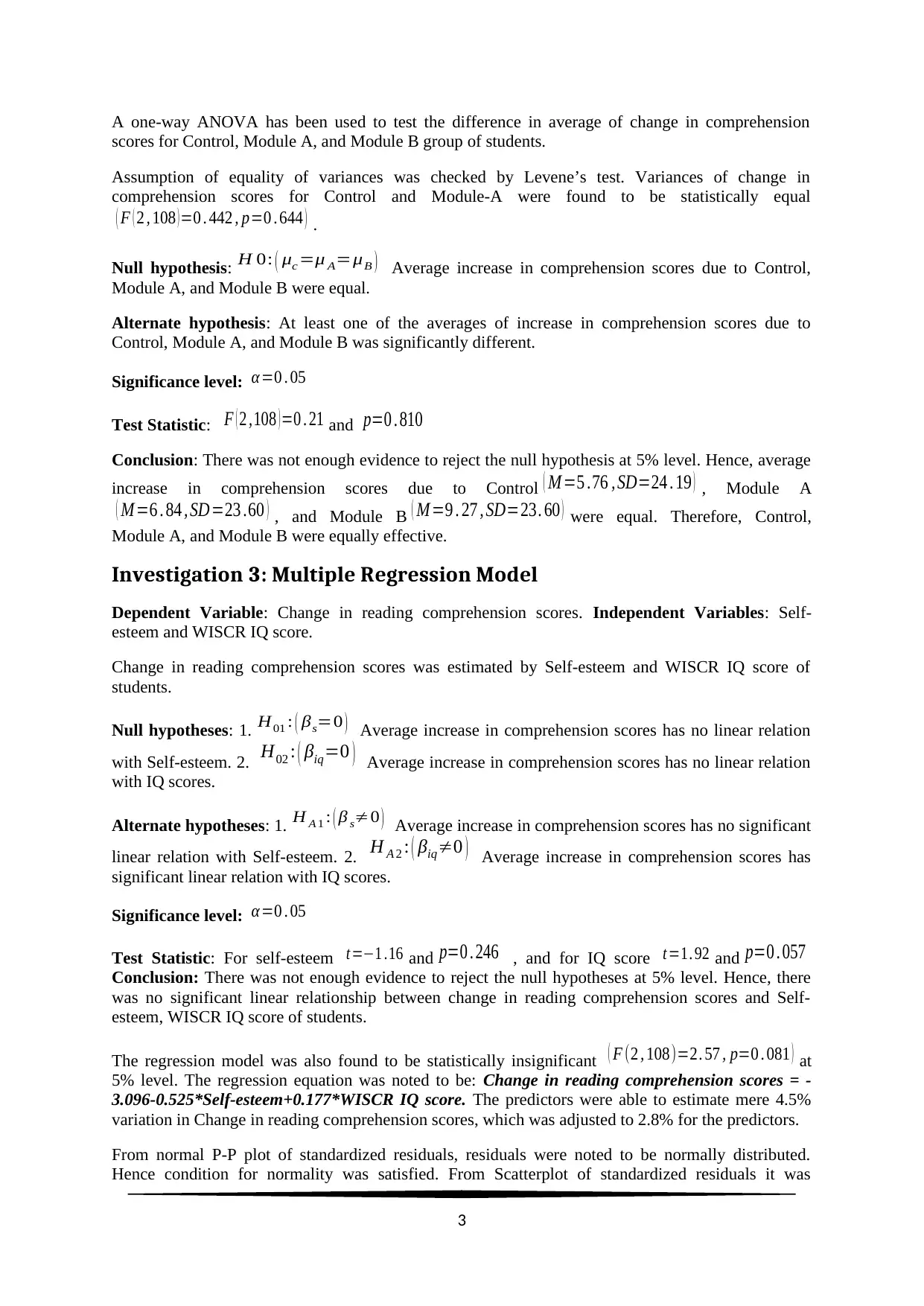
A one-way ANOVA has been used to test the difference in average of change in comprehension
scores for Control, Module A, and Module B group of students.
Assumption of equality of variances was checked by Levene’s test. Variances of change in
comprehension scores for Control and Module-A were found to be statistically equal
( F ( 2 , 108 ) =0 . 442 , p=0 . 644 ) .
Null hypothesis: H 0: ( μc =μ A=μB ) Average increase in comprehension scores due to Control,
Module A, and Module B were equal.
Alternate hypothesis: At least one of the averages of increase in comprehension scores due to
Control, Module A, and Module B was significantly different.
Significance level: α=0 . 05
Test Statistic: F ( 2 ,108 ) =0 . 21 and p=0 . 810
Conclusion: There was not enough evidence to reject the null hypothesis at 5% level. Hence, average
increase in comprehension scores due to Control ( M =5 .76 , SD=24 . 19 ) , Module A
( M =6 . 84 , SD=23 .60 ) , and Module B ( M =9 . 27 , SD=23. 60 ) were equal. Therefore, Control,
Module A, and Module B were equally effective.
Investigation 3: Multiple Regression Model
Dependent Variable: Change in reading comprehension scores. Independent Variables: Self-
esteem and WISCR IQ score.
Change in reading comprehension scores was estimated by Self-esteem and WISCR IQ score of
students.
Null hypotheses: 1. H01 : ( βs=0 ) Average increase in comprehension scores has no linear relation
with Self-esteem. 2. H02 : ( βiq=0 ) Average increase in comprehension scores has no linear relation
with IQ scores.
Alternate hypotheses: 1. H A 1 : ( β s≠0 ) Average increase in comprehension scores has no significant
linear relation with Self-esteem. 2. H A 2 : ( βiq≠0 ) Average increase in comprehension scores has
significant linear relation with IQ scores.
Significance level: α=0 . 05
Test Statistic: For self-esteem t=−1 .16 and p=0 . 246 , and for IQ score t=1. 92 and p=0 . 057
Conclusion: There was not enough evidence to reject the null hypotheses at 5% level. Hence, there
was no significant linear relationship between change in reading comprehension scores and Self-
esteem, WISCR IQ score of students.
The regression model was also found to be statistically insignificant ( F (2 , 108)=2. 57 , p=0 . 081 ) at
5% level. The regression equation was noted to be: Change in reading comprehension scores = -
3.096-0.525*Self-esteem+0.177*WISCR IQ score. The predictors were able to estimate mere 4.5%
variation in Change in reading comprehension scores, which was adjusted to 2.8% for the predictors.
From normal P-P plot of standardized residuals, residuals were noted to be normally distributed.
Hence condition for normality was satisfied. From Scatterplot of standardized residuals it was
3
scores for Control, Module A, and Module B group of students.
Assumption of equality of variances was checked by Levene’s test. Variances of change in
comprehension scores for Control and Module-A were found to be statistically equal
( F ( 2 , 108 ) =0 . 442 , p=0 . 644 ) .
Null hypothesis: H 0: ( μc =μ A=μB ) Average increase in comprehension scores due to Control,
Module A, and Module B were equal.
Alternate hypothesis: At least one of the averages of increase in comprehension scores due to
Control, Module A, and Module B was significantly different.
Significance level: α=0 . 05
Test Statistic: F ( 2 ,108 ) =0 . 21 and p=0 . 810
Conclusion: There was not enough evidence to reject the null hypothesis at 5% level. Hence, average
increase in comprehension scores due to Control ( M =5 .76 , SD=24 . 19 ) , Module A
( M =6 . 84 , SD=23 .60 ) , and Module B ( M =9 . 27 , SD=23. 60 ) were equal. Therefore, Control,
Module A, and Module B were equally effective.
Investigation 3: Multiple Regression Model
Dependent Variable: Change in reading comprehension scores. Independent Variables: Self-
esteem and WISCR IQ score.
Change in reading comprehension scores was estimated by Self-esteem and WISCR IQ score of
students.
Null hypotheses: 1. H01 : ( βs=0 ) Average increase in comprehension scores has no linear relation
with Self-esteem. 2. H02 : ( βiq=0 ) Average increase in comprehension scores has no linear relation
with IQ scores.
Alternate hypotheses: 1. H A 1 : ( β s≠0 ) Average increase in comprehension scores has no significant
linear relation with Self-esteem. 2. H A 2 : ( βiq≠0 ) Average increase in comprehension scores has
significant linear relation with IQ scores.
Significance level: α=0 . 05
Test Statistic: For self-esteem t=−1 .16 and p=0 . 246 , and for IQ score t=1. 92 and p=0 . 057
Conclusion: There was not enough evidence to reject the null hypotheses at 5% level. Hence, there
was no significant linear relationship between change in reading comprehension scores and Self-
esteem, WISCR IQ score of students.
The regression model was also found to be statistically insignificant ( F (2 , 108)=2. 57 , p=0 . 081 ) at
5% level. The regression equation was noted to be: Change in reading comprehension scores = -
3.096-0.525*Self-esteem+0.177*WISCR IQ score. The predictors were able to estimate mere 4.5%
variation in Change in reading comprehension scores, which was adjusted to 2.8% for the predictors.
From normal P-P plot of standardized residuals, residuals were noted to be normally distributed.
Hence condition for normality was satisfied. From Scatterplot of standardized residuals it was
3
⊘ This is a preview!⊘
Do you want full access?
Subscribe today to unlock all pages.

Trusted by 1+ million students worldwide
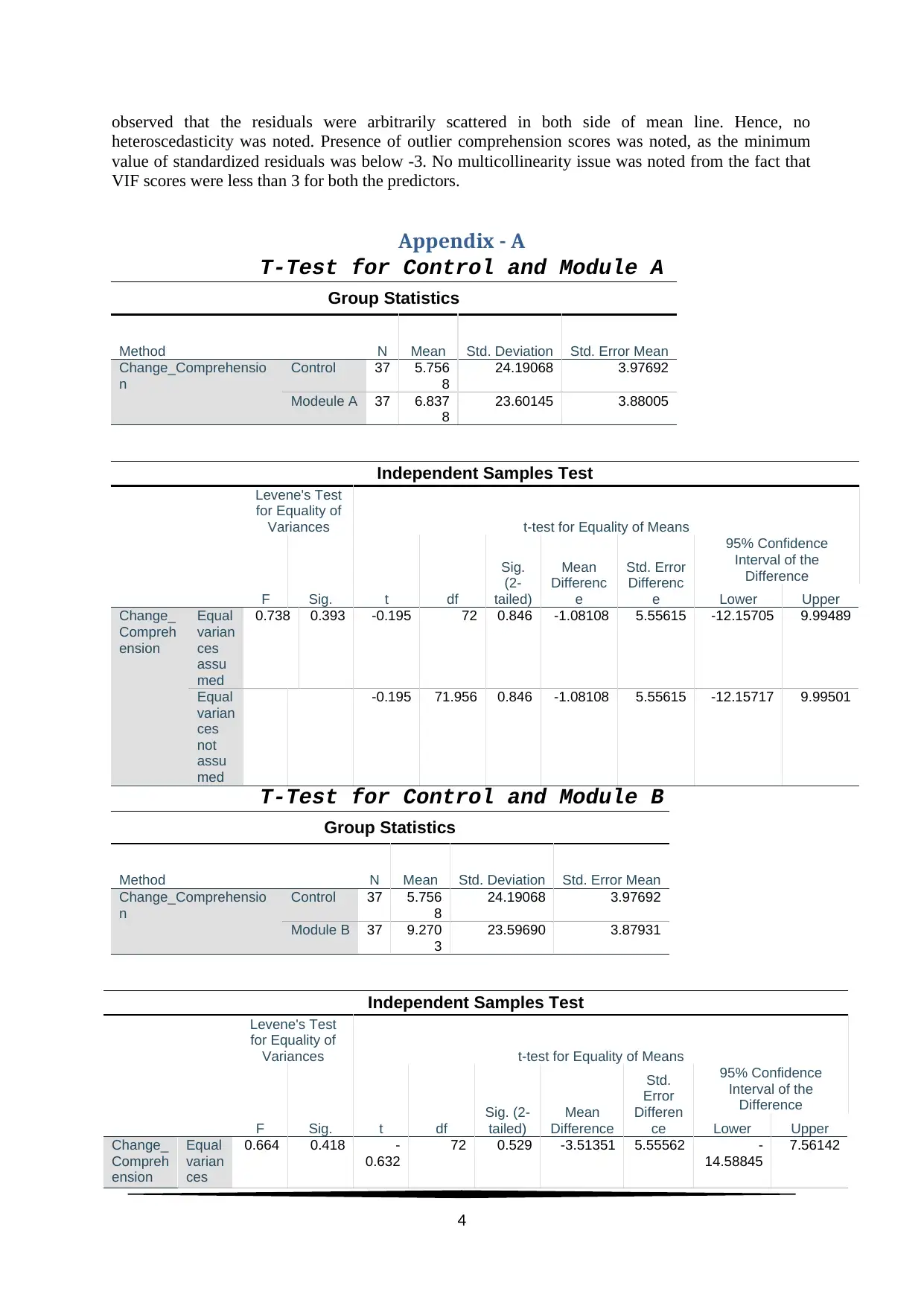
observed that the residuals were arbitrarily scattered in both side of mean line. Hence, no
heteroscedasticity was noted. Presence of outlier comprehension scores was noted, as the minimum
value of standardized residuals was below -3. No multicollinearity issue was noted from the fact that
VIF scores were less than 3 for both the predictors.
Appendix - A
T-Test for Control and Module A
Group Statistics
Method N Mean Std. Deviation Std. Error Mean
Change_Comprehensio
n
Control 37 5.756
8
24.19068 3.97692
Modeule A 37 6.837
8
23.60145 3.88005
Independent Samples Test
Levene's Test
for Equality of
Variances t-test for Equality of Means
F Sig. t df
Sig.
(2-
tailed)
Mean
Differenc
e
Std. Error
Differenc
e
95% Confidence
Interval of the
Difference
Lower Upper
Change_
Compreh
ension
Equal
varian
ces
assu
med
0.738 0.393 -0.195 72 0.846 -1.08108 5.55615 -12.15705 9.99489
Equal
varian
ces
not
assu
med
-0.195 71.956 0.846 -1.08108 5.55615 -12.15717 9.99501
T-Test for Control and Module B
Group Statistics
Method N Mean Std. Deviation Std. Error Mean
Change_Comprehensio
n
Control 37 5.756
8
24.19068 3.97692
Module B 37 9.270
3
23.59690 3.87931
Independent Samples Test
Levene's Test
for Equality of
Variances t-test for Equality of Means
F Sig. t df
Sig. (2-
tailed)
Mean
Difference
Std.
Error
Differen
ce
95% Confidence
Interval of the
Difference
Lower Upper
Change_
Compreh
ension
Equal
varian
ces
0.664 0.418 -
0.632
72 0.529 -3.51351 5.55562 -
14.58845
7.56142
4
heteroscedasticity was noted. Presence of outlier comprehension scores was noted, as the minimum
value of standardized residuals was below -3. No multicollinearity issue was noted from the fact that
VIF scores were less than 3 for both the predictors.
Appendix - A
T-Test for Control and Module A
Group Statistics
Method N Mean Std. Deviation Std. Error Mean
Change_Comprehensio
n
Control 37 5.756
8
24.19068 3.97692
Modeule A 37 6.837
8
23.60145 3.88005
Independent Samples Test
Levene's Test
for Equality of
Variances t-test for Equality of Means
F Sig. t df
Sig.
(2-
tailed)
Mean
Differenc
e
Std. Error
Differenc
e
95% Confidence
Interval of the
Difference
Lower Upper
Change_
Compreh
ension
Equal
varian
ces
assu
med
0.738 0.393 -0.195 72 0.846 -1.08108 5.55615 -12.15705 9.99489
Equal
varian
ces
not
assu
med
-0.195 71.956 0.846 -1.08108 5.55615 -12.15717 9.99501
T-Test for Control and Module B
Group Statistics
Method N Mean Std. Deviation Std. Error Mean
Change_Comprehensio
n
Control 37 5.756
8
24.19068 3.97692
Module B 37 9.270
3
23.59690 3.87931
Independent Samples Test
Levene's Test
for Equality of
Variances t-test for Equality of Means
F Sig. t df
Sig. (2-
tailed)
Mean
Difference
Std.
Error
Differen
ce
95% Confidence
Interval of the
Difference
Lower Upper
Change_
Compreh
ension
Equal
varian
ces
0.664 0.418 -
0.632
72 0.529 -3.51351 5.55562 -
14.58845
7.56142
4
Paraphrase This Document
Need a fresh take? Get an instant paraphrase of this document with our AI Paraphraser
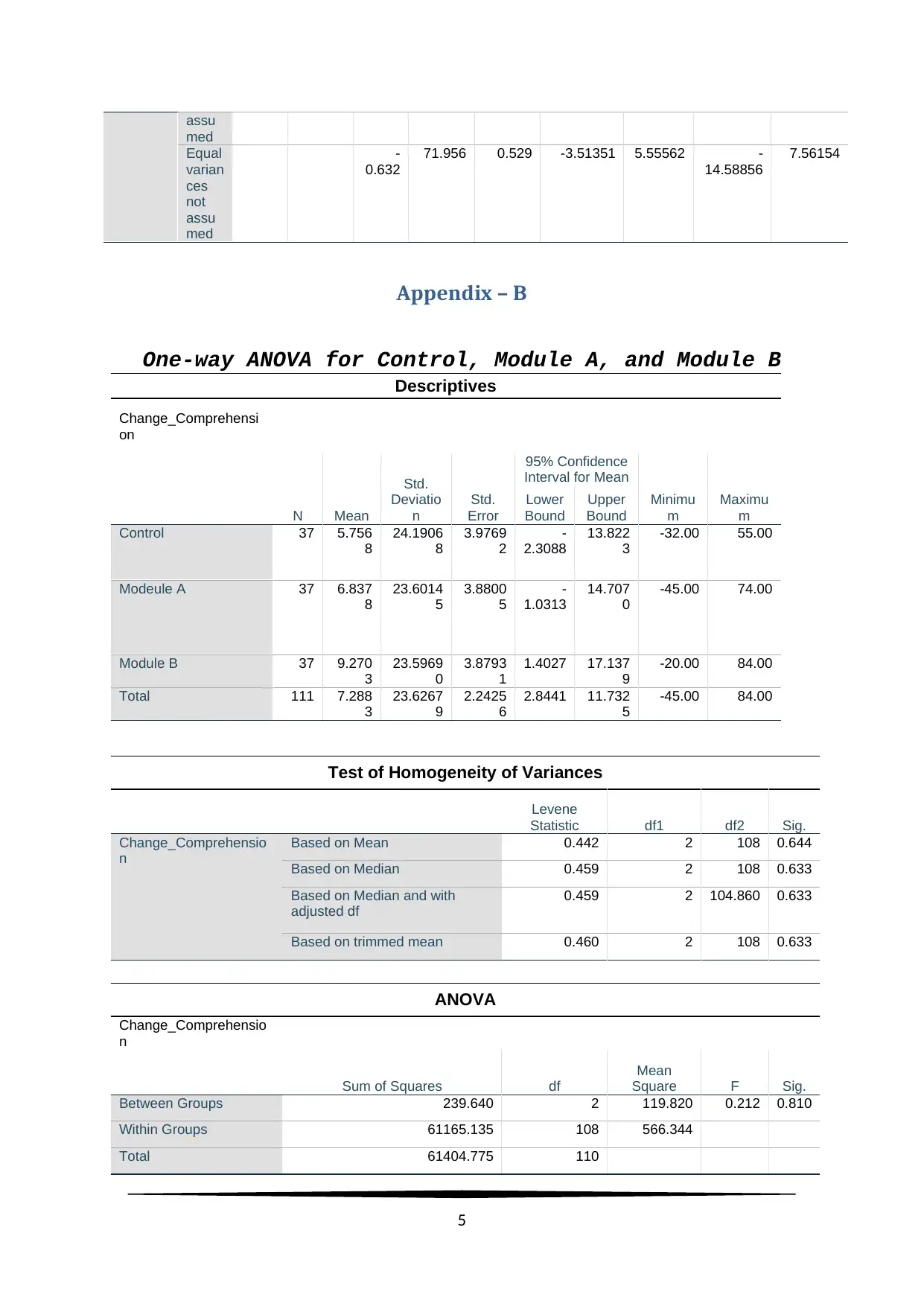
assu
med
Equal
varian
ces
not
assu
med
-
0.632
71.956 0.529 -3.51351 5.55562 -
14.58856
7.56154
Appendix – B
One-way ANOVA for Control, Module A, and Module B
Descriptives
Change_Comprehensi
on
N Mean
Std.
Deviatio
n
Std.
Error
95% Confidence
Interval for Mean
Minimu
m
Maximu
m
Lower
Bound
Upper
Bound
Control 37 5.756
8
24.1906
8
3.9769
2
-
2.3088
13.822
3
-32.00 55.00
Modeule A 37 6.837
8
23.6014
5
3.8800
5
-
1.0313
14.707
0
-45.00 74.00
Module B 37 9.270
3
23.5969
0
3.8793
1
1.4027 17.137
9
-20.00 84.00
Total 111 7.288
3
23.6267
9
2.2425
6
2.8441 11.732
5
-45.00 84.00
Test of Homogeneity of Variances
Levene
Statistic df1 df2 Sig.
Change_Comprehensio
n
Based on Mean 0.442 2 108 0.644
Based on Median 0.459 2 108 0.633
Based on Median and with
adjusted df
0.459 2 104.860 0.633
Based on trimmed mean 0.460 2 108 0.633
ANOVA
Change_Comprehensio
n
Sum of Squares df
Mean
Square F Sig.
Between Groups 239.640 2 119.820 0.212 0.810
Within Groups 61165.135 108 566.344
Total 61404.775 110
5
med
Equal
varian
ces
not
assu
med
-
0.632
71.956 0.529 -3.51351 5.55562 -
14.58856
7.56154
Appendix – B
One-way ANOVA for Control, Module A, and Module B
Descriptives
Change_Comprehensi
on
N Mean
Std.
Deviatio
n
Std.
Error
95% Confidence
Interval for Mean
Minimu
m
Maximu
m
Lower
Bound
Upper
Bound
Control 37 5.756
8
24.1906
8
3.9769
2
-
2.3088
13.822
3
-32.00 55.00
Modeule A 37 6.837
8
23.6014
5
3.8800
5
-
1.0313
14.707
0
-45.00 74.00
Module B 37 9.270
3
23.5969
0
3.8793
1
1.4027 17.137
9
-20.00 84.00
Total 111 7.288
3
23.6267
9
2.2425
6
2.8441 11.732
5
-45.00 84.00
Test of Homogeneity of Variances
Levene
Statistic df1 df2 Sig.
Change_Comprehensio
n
Based on Mean 0.442 2 108 0.644
Based on Median 0.459 2 108 0.633
Based on Median and with
adjusted df
0.459 2 104.860 0.633
Based on trimmed mean 0.460 2 108 0.633
ANOVA
Change_Comprehensio
n
Sum of Squares df
Mean
Square F Sig.
Between Groups 239.640 2 119.820 0.212 0.810
Within Groups 61165.135 108 566.344
Total 61404.775 110
5
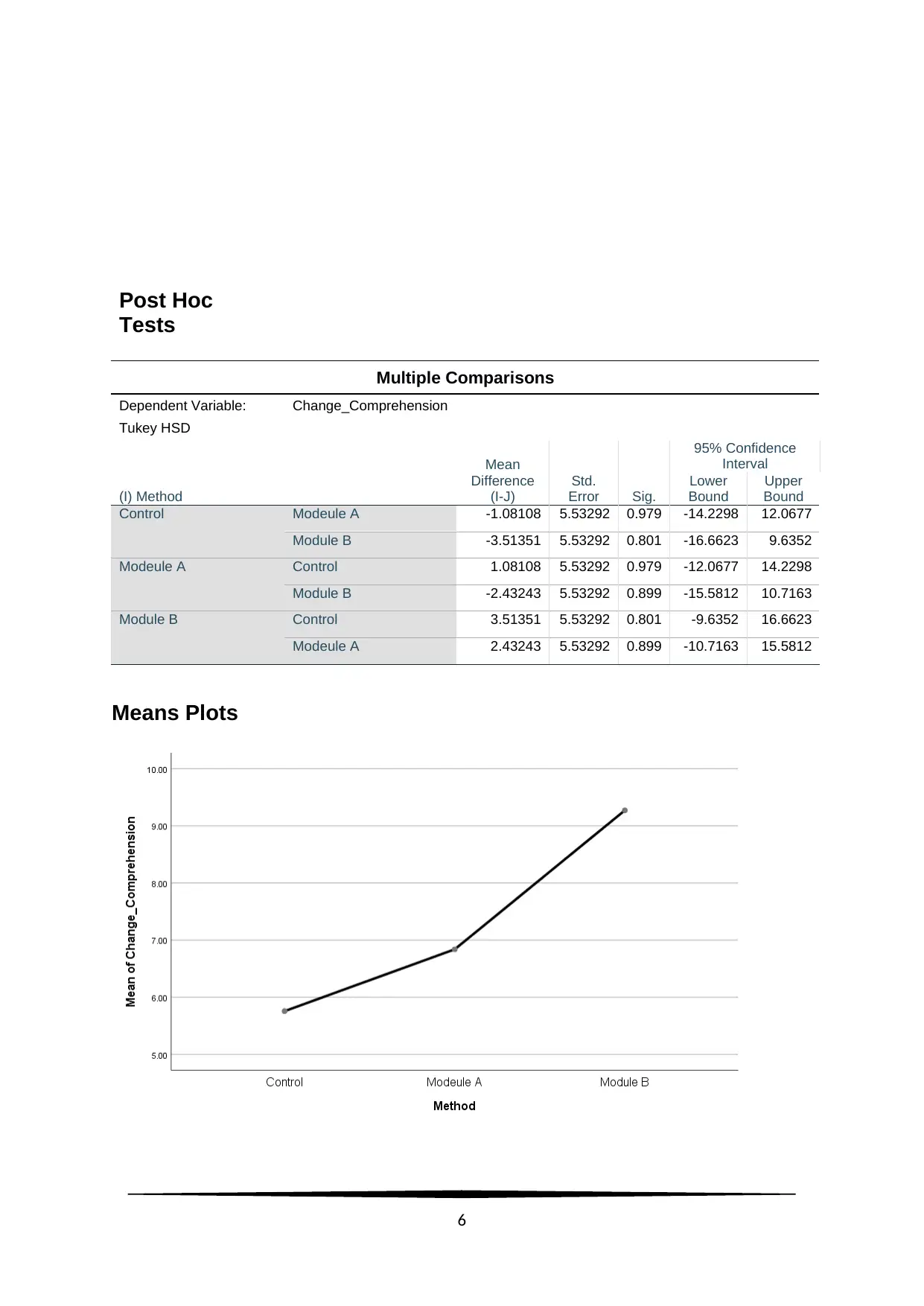
Post Hoc
Tests
Multiple Comparisons
Dependent Variable: Change_Comprehension
Tukey HSD
(I) Method
Mean
Difference
(I-J)
Std.
Error Sig.
95% Confidence
Interval
Lower
Bound
Upper
Bound
Control Modeule A -1.08108 5.53292 0.979 -14.2298 12.0677
Module B -3.51351 5.53292 0.801 -16.6623 9.6352
Modeule A Control 1.08108 5.53292 0.979 -12.0677 14.2298
Module B -2.43243 5.53292 0.899 -15.5812 10.7163
Module B Control 3.51351 5.53292 0.801 -9.6352 16.6623
Modeule A 2.43243 5.53292 0.899 -10.7163 15.5812
Means Plots
6
Tests
Multiple Comparisons
Dependent Variable: Change_Comprehension
Tukey HSD
(I) Method
Mean
Difference
(I-J)
Std.
Error Sig.
95% Confidence
Interval
Lower
Bound
Upper
Bound
Control Modeule A -1.08108 5.53292 0.979 -14.2298 12.0677
Module B -3.51351 5.53292 0.801 -16.6623 9.6352
Modeule A Control 1.08108 5.53292 0.979 -12.0677 14.2298
Module B -2.43243 5.53292 0.899 -15.5812 10.7163
Module B Control 3.51351 5.53292 0.801 -9.6352 16.6623
Modeule A 2.43243 5.53292 0.899 -10.7163 15.5812
Means Plots
6
⊘ This is a preview!⊘
Do you want full access?
Subscribe today to unlock all pages.

Trusted by 1+ million students worldwide
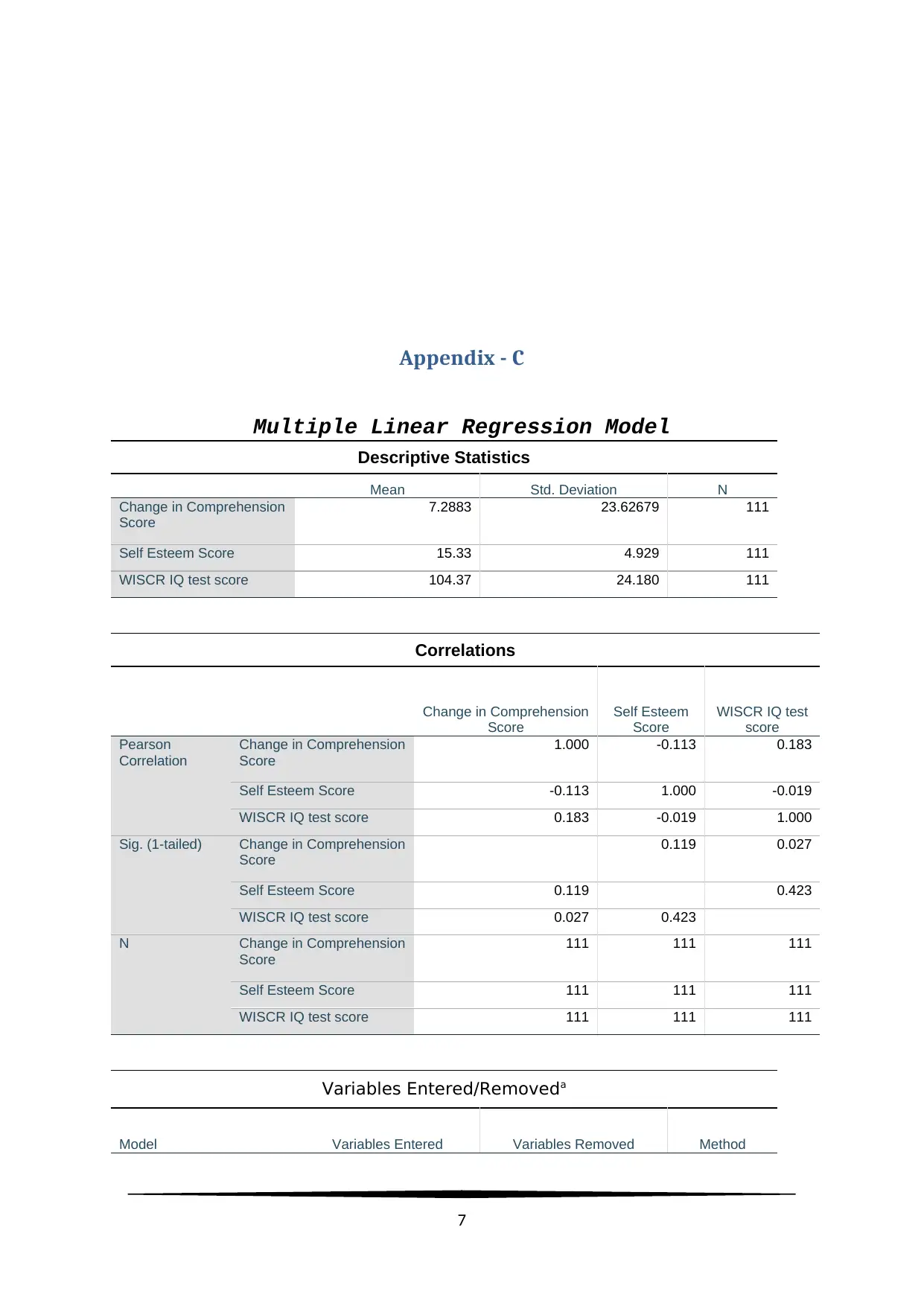
Appendix - C
Multiple Linear Regression Model
Descriptive Statistics
Mean Std. Deviation N
Change in Comprehension
Score
7.2883 23.62679 111
Self Esteem Score 15.33 4.929 111
WISCR IQ test score 104.37 24.180 111
Correlations
Change in Comprehension
Score
Self Esteem
Score
WISCR IQ test
score
Pearson
Correlation
Change in Comprehension
Score
1.000 -0.113 0.183
Self Esteem Score -0.113 1.000 -0.019
WISCR IQ test score 0.183 -0.019 1.000
Sig. (1-tailed) Change in Comprehension
Score
0.119 0.027
Self Esteem Score 0.119 0.423
WISCR IQ test score 0.027 0.423
N Change in Comprehension
Score
111 111 111
Self Esteem Score 111 111 111
WISCR IQ test score 111 111 111
Variables Entered/Removeda
Model Variables Entered Variables Removed Method
7
Multiple Linear Regression Model
Descriptive Statistics
Mean Std. Deviation N
Change in Comprehension
Score
7.2883 23.62679 111
Self Esteem Score 15.33 4.929 111
WISCR IQ test score 104.37 24.180 111
Correlations
Change in Comprehension
Score
Self Esteem
Score
WISCR IQ test
score
Pearson
Correlation
Change in Comprehension
Score
1.000 -0.113 0.183
Self Esteem Score -0.113 1.000 -0.019
WISCR IQ test score 0.183 -0.019 1.000
Sig. (1-tailed) Change in Comprehension
Score
0.119 0.027
Self Esteem Score 0.119 0.423
WISCR IQ test score 0.027 0.423
N Change in Comprehension
Score
111 111 111
Self Esteem Score 111 111 111
WISCR IQ test score 111 111 111
Variables Entered/Removeda
Model Variables Entered Variables Removed Method
7
Paraphrase This Document
Need a fresh take? Get an instant paraphrase of this document with our AI Paraphraser

1 WISCR IQ test score , Self
Esteem Scoreb
Enter
a. Dependent Variable: Change in Comprehension Score
b. All requested variables entered.
Model Summaryb
Model R
R
Square
Adjusted
R
Square
Std.
Error of
the
Estimate
Change Statistics
R
Square
Change
F
Change df1 df2
Sig. F
Change
1 .213a 0.045 0.028 23.2966
8
0.045 2.570 2 108 0.081
a. Predictors: (Constant), WISCR IQ test score , Self Esteem Score
b. Dependent Variable: Change in Comprehension Score
ANOVAa
Model
Sum of
Squares df
Mean
Square F Sig.
1 Regression 2789.350 2 1394.675 2.570 .081b
Residual 58615.42
5
108 542.735
Total 61404.77
5
110
a. Dependent Variable: Change in Comprehension Score
b. Predictors: (Constant), WISCR IQ test score , Self Esteem Score
Coefficientsa
Model
Unstandardized
Coefficients
Standardized
Coefficients
t Sig.
95.0% Confidence
Interval for B
Collinearity
Statistics
B
Std.
Error Beta
Lower
Bound
Upper
Bound Tolerance VIF
1 (Constant) -3.096 12.127 -0.255 0.799 -27.134 20.942
Self
Esteem
Score
-0.525 0.451 -0.110 -1.165 0.246 -1.419 0.368 1.000 1.000
WISCR IQ
test score
0.177 0.092 0.181 1.923 0.057 -0.005 0.359 1.000 1.000
a. Dependent Variable: Change in Comprehension Score
Collinearity Diagnosticsa
Mode Eigenvalue Condition Variance Proportions
8
Esteem Scoreb
Enter
a. Dependent Variable: Change in Comprehension Score
b. All requested variables entered.
Model Summaryb
Model R
R
Square
Adjusted
R
Square
Std.
Error of
the
Estimate
Change Statistics
R
Square
Change
F
Change df1 df2
Sig. F
Change
1 .213a 0.045 0.028 23.2966
8
0.045 2.570 2 108 0.081
a. Predictors: (Constant), WISCR IQ test score , Self Esteem Score
b. Dependent Variable: Change in Comprehension Score
ANOVAa
Model
Sum of
Squares df
Mean
Square F Sig.
1 Regression 2789.350 2 1394.675 2.570 .081b
Residual 58615.42
5
108 542.735
Total 61404.77
5
110
a. Dependent Variable: Change in Comprehension Score
b. Predictors: (Constant), WISCR IQ test score , Self Esteem Score
Coefficientsa
Model
Unstandardized
Coefficients
Standardized
Coefficients
t Sig.
95.0% Confidence
Interval for B
Collinearity
Statistics
B
Std.
Error Beta
Lower
Bound
Upper
Bound Tolerance VIF
1 (Constant) -3.096 12.127 -0.255 0.799 -27.134 20.942
Self
Esteem
Score
-0.525 0.451 -0.110 -1.165 0.246 -1.419 0.368 1.000 1.000
WISCR IQ
test score
0.177 0.092 0.181 1.923 0.057 -0.005 0.359 1.000 1.000
a. Dependent Variable: Change in Comprehension Score
Collinearity Diagnosticsa
Mode Eigenvalue Condition Variance Proportions
8
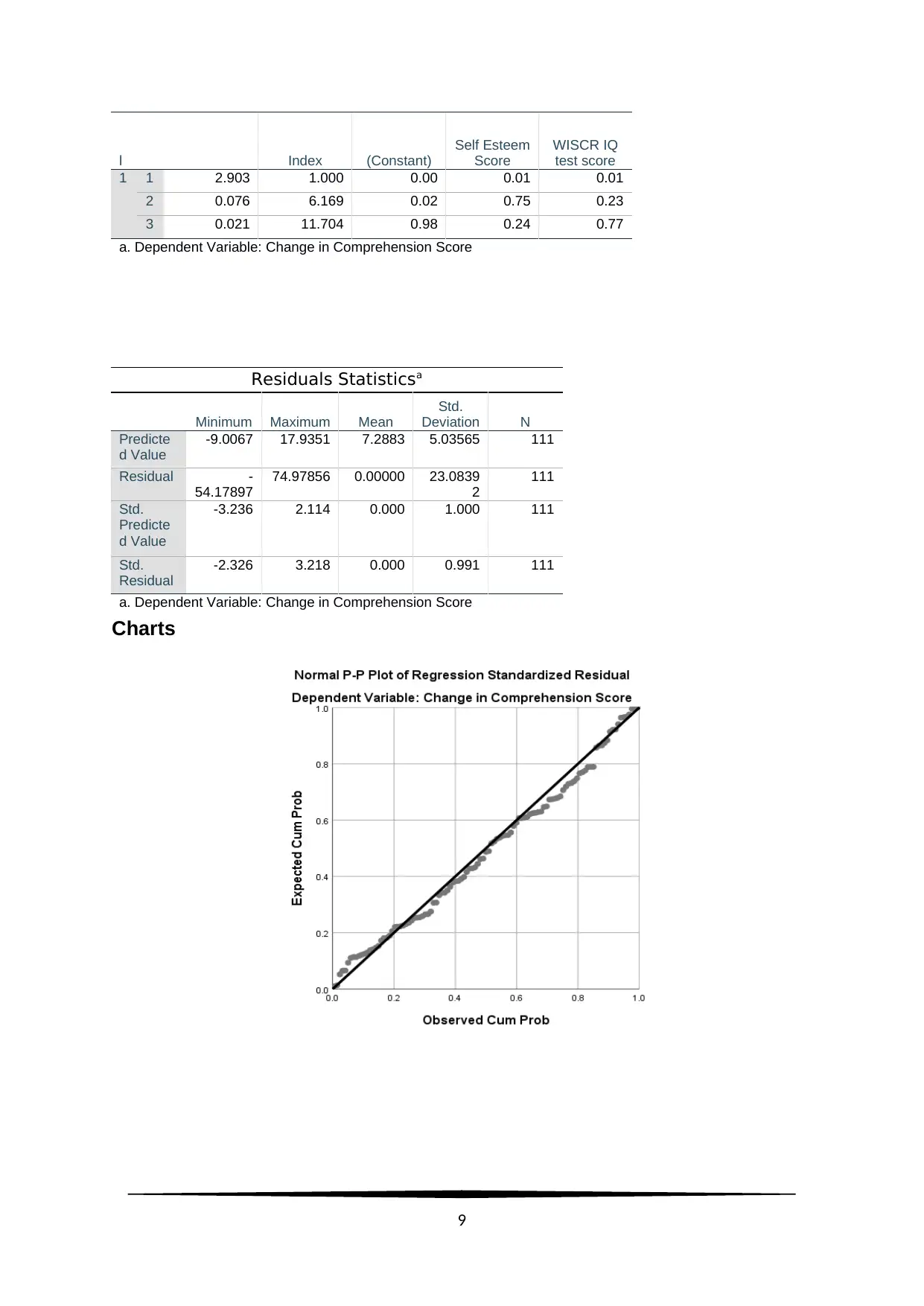
l Index (Constant)
Self Esteem
Score
WISCR IQ
test score
1 1 2.903 1.000 0.00 0.01 0.01
2 0.076 6.169 0.02 0.75 0.23
3 0.021 11.704 0.98 0.24 0.77
a. Dependent Variable: Change in Comprehension Score
Residuals Statisticsa
Minimum Maximum Mean
Std.
Deviation N
Predicte
d Value
-9.0067 17.9351 7.2883 5.03565 111
Residual -
54.17897
74.97856 0.00000 23.0839
2
111
Std.
Predicte
d Value
-3.236 2.114 0.000 1.000 111
Std.
Residual
-2.326 3.218 0.000 0.991 111
a. Dependent Variable: Change in Comprehension Score
Charts
9
Self Esteem
Score
WISCR IQ
test score
1 1 2.903 1.000 0.00 0.01 0.01
2 0.076 6.169 0.02 0.75 0.23
3 0.021 11.704 0.98 0.24 0.77
a. Dependent Variable: Change in Comprehension Score
Residuals Statisticsa
Minimum Maximum Mean
Std.
Deviation N
Predicte
d Value
-9.0067 17.9351 7.2883 5.03565 111
Residual -
54.17897
74.97856 0.00000 23.0839
2
111
Std.
Predicte
d Value
-3.236 2.114 0.000 1.000 111
Std.
Residual
-2.326 3.218 0.000 0.991 111
a. Dependent Variable: Change in Comprehension Score
Charts
9
⊘ This is a preview!⊘
Do you want full access?
Subscribe today to unlock all pages.

Trusted by 1+ million students worldwide
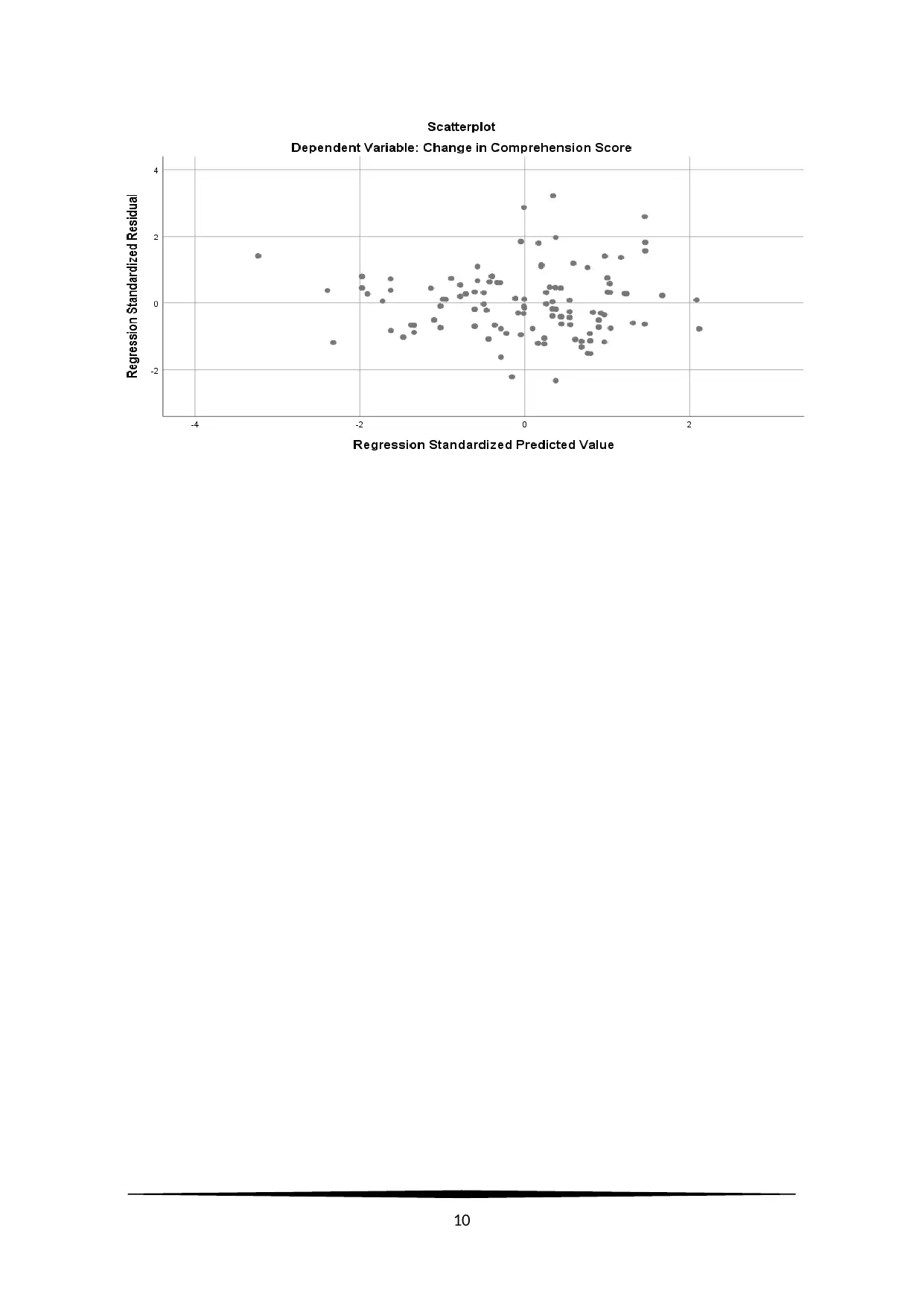
10
1 out of 10
Related Documents
Your All-in-One AI-Powered Toolkit for Academic Success.
+13062052269
info@desklib.com
Available 24*7 on WhatsApp / Email
![[object Object]](/_next/static/media/star-bottom.7253800d.svg)
Unlock your academic potential
Copyright © 2020–2025 A2Z Services. All Rights Reserved. Developed and managed by ZUCOL.





